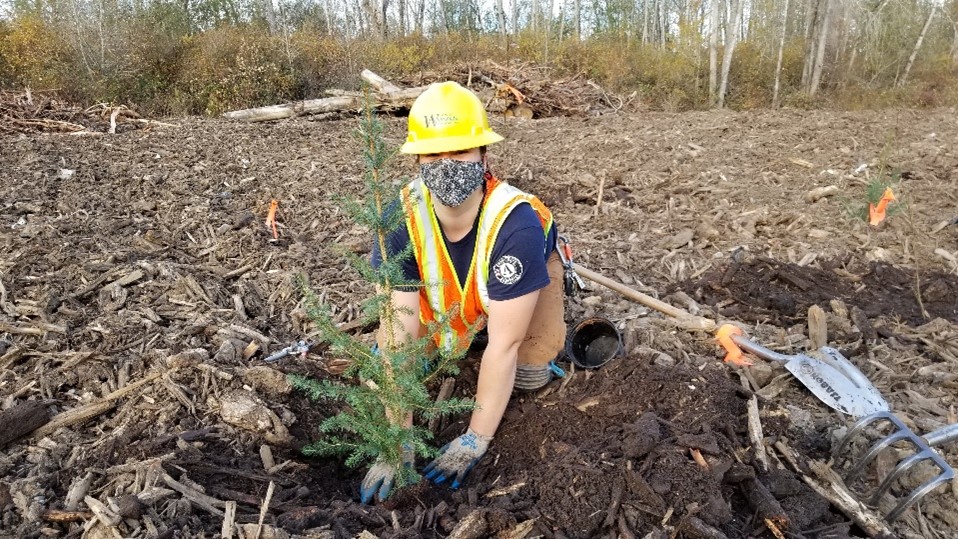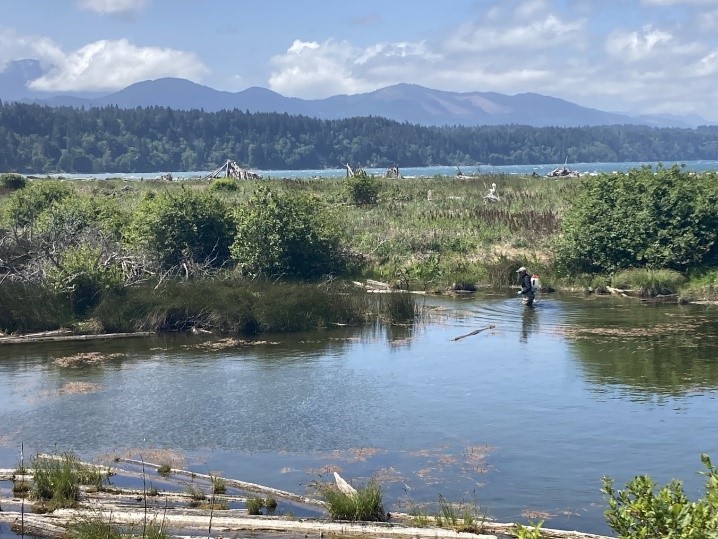Welcome to part two of clean water highlights from our 2021-2023 Biennium Outcomes Report. In part one we talked about how our clean water funding supports wastewater and stormwater investments. Our funding covers many different methods to improve water quality, and we are excited to share more success stories! Wondering if we have funded any clean water projects in your community? Check out our outcomes report and most recent funding announcement to find out.
Triple Creek floodplain connection
The Okanogan Highlands Alliance (OHA) received $159,564 from the Clean Water Section 319 grant to reduce sediment and water temperature in Myers Creek, a part of the Triple Creek wetland. The project site is located at the base of Buckhorn Mountain where three creeks converge to form a 100-acre wetland. The wetland once supported healthy water quality and ecological functions but lost much of this functionality when Myers Creek became deeply incised in the late 1990s. The incision disconnected the stream from its floodplain and resulted in degraded habitat and the loss of important floodplain processes that maintain and improve water quality.
OHA focused on re-establishing a healthy floodplain on a reach of Myers Creek by adding and enhancing beaver dam analogues (BDAs) and planting additional native species in the riparian buffer zone. BDAs function like natural beaver dams, helping sediment to settle and build up the streambed and water table. This supports native wetland vegetation and discourages weeds, creating a positive biofeedback cycle.
Combining instream work, buffer enhancement, and effective outreach will catalyze wetland recovery and restore water quality function. Protected by a conservation easement, this project ensures long-term public conservation benefits.
“The native plantings are thriving. Watching snowberries self-propagate shows us that the ecosystem is ripe for transformation away from the baseline bi-culture of alder and reed canarygrass toward a more complex ecosystem. We have added diversity and density to the plant community and engaged in a highly effective mowing effort to suppress reed canarygrass. The robust growth of our plantings despite drought conditions exceeded expectations.” – Okanogan Highlands Alliance
Squalicum Creek wetland restoration
The City of Bellingham received over $1.2 million in Ecology grants and loans to reduce water temperature, dissolved oxygen levels (DO), and fecal coliform in Squalicum Creek. Squalicum Creek is a tributary of Bellingham Bay that offers human recreation and supports habitat for Chinook and Steelhead salmonids. The water quality and fish stocks began declining when the creek was connected to two man-made waterbodies, Bug Lake and Sunset Pond. These shallow and wide lakes absorbed solar heat, creating high surface temperatures and low dissolved oxygen levels. These conditions are unsuitable for salmonids.
This is the third phase of a large-scale project to implement actions from the Whatcom, Squalicum, and Padden Creeks Temperature TMDL (Total Maximum Daily Load) Water Quality Improvement Plan. The city re-routed 640 feet of the creek through a new stream channel, partially filled Bug Lake to create 5.5 acres of wetlands, and implemented education and monitoring programs.
Native tree planting in the City of Bellingham.
The new channel will narrow the stream width from 270 ft to 20 feet, significantly increasing effective shade from 0-20% to 86%. This will lower the amount of time water is in the ponds, improving DO levels and creating beneficial wetlands for filtering. Vegetation enhancements will increase shading and improve fish habitat. Education and volunteer opportunities promote stewardship, the most cost-effective method for maintaining water quality.
The city creatively used their Clean Water State Revolving Fund and forgivable principal loans to fund this restoration project.
“Thank you for the opportunity to make meaningful on-the-ground improvements to the Squalicum Creek watershed. We are confident the project will result in long-term water quality and habitat benefits.” – City of Bellingham
Protecting the Elwha Estuary from aquatic invasives
Invasive aquatic plant eradication in the Elwha estuary
The Lower Elwha Klallam Tribe received $50,000 from the Aquatic Invasive Plant Management Program grant and used it to remove the invasive Eurasian watermilfoil from the Elwha estuary. Eurasian watermilfoil grows in thick mats that shade out native vegetation. It offers little to no habitat or food for native wildlife, and alters water quality by clogging streams, reducing flows, decreasing oxygen levels, and increasing water temperature. If left unchecked, its presence can harm the whole estuarine system and nearby freshwater environments. It is listed as a noxious weed on the state quarantine list.
Drastically reducing Eurasian watermilfoil will create conditions for fish to thrive and continue to populate the Elwha River. It will also allow native vegetation to thrive in the newly forming estuary. The Tribe’s work protects diverse native plant and fish communities to better provide a resource for Elwha people to gather traditional plant medicine, food, and plant products while also providing a refuge for wildlife.
“Thank you, Department of Ecology, for helping us eradicate this threatening, noxious weed in the salmonid nursery of the Elwha River!” – Lower Elwha Klallam Tribe
Managing harmful algal blooms in Lake Marcel
King County used $50,000 from the Freshwater Algae Control Program grant to develop a management strategy to reduce the frequency and duration of harmful algal blooms on Lake Marcel. Harmful cyanobacteria blooms have become more frequent in Lake Marcel and exceed state algae toxin guidelines. These levels of cyanobacteria can harm wildlife and result in the waterbody being closed for recreation.
The management plan creates a strategy targeting phosphorus control and provides guidelines for ongoing monitoring and managing of nuisance aquatic vegetation. Possible actions include:
- Managing stormwater and septic systems for incoming phosphorus.
- Using chemicals and innovative methods like nanobubbles or ultrasonic barriers to control phosphorus already in the lake.
“Thank you for the opportunity this grant gave the community. We have a plan in place that the community can support, and we look forward to future work and implementation of the plan.” – King County Natural Resources and Parks Department
Spanish-language education and outreach
WSU utilizes a watershed model as a key outreach tool.
Washington State University received nearly $100,000 from a Puget Sound National Estuary Program Stormwater Strategic Initiative grant to provide Spanish-language materials on stormwater pollution in the Snohomish and Stillaguamish Watersheds.
The University prioritized Spanish-speaking communities in Everett and Monroe. Volunteers and interns provided education and outreach about water quality and pollution prevention in Spanish. These efforts reached over 40,000 community members through 22 events, six workshops, and a large-scale social media campaign to continue outreach during pandemic restrictions in 2021.
The campaign educated community members on many ways to reduce water pollution like bagging and putting pet waste in garbage cans, installing rain gardens, and keeping used motor oil and other items out of storm drains.
“Thank you for supporting this important project! Having resources on water quality available in Spanish to the Latinx community is extremely important.” – Washington State University
We provide millions of dollars of funding to improve, protect, and restore water quality across the state. We have several opportunities that vary by funding source, funding category, and type of project. The largest opportunity is our Water Quality Combined Fund where we provide a single application process to fund a variety of projects.
Our water quality grants and loans page provides more information about our funding and resources.

